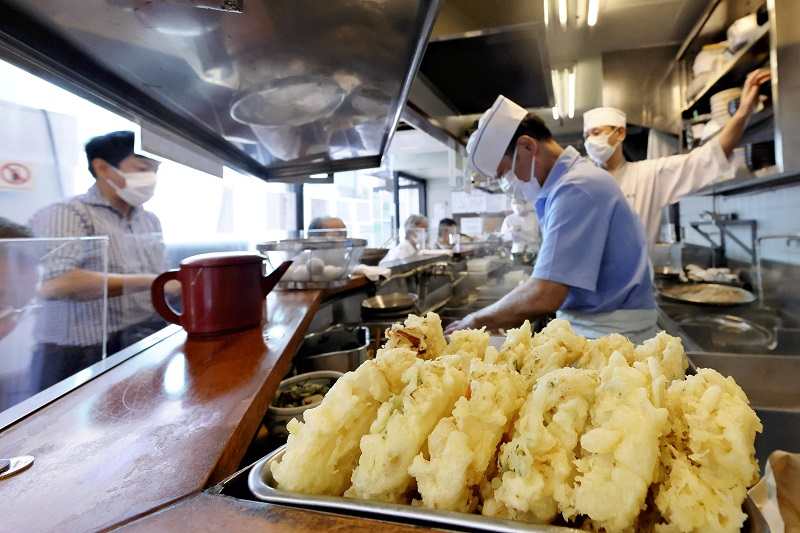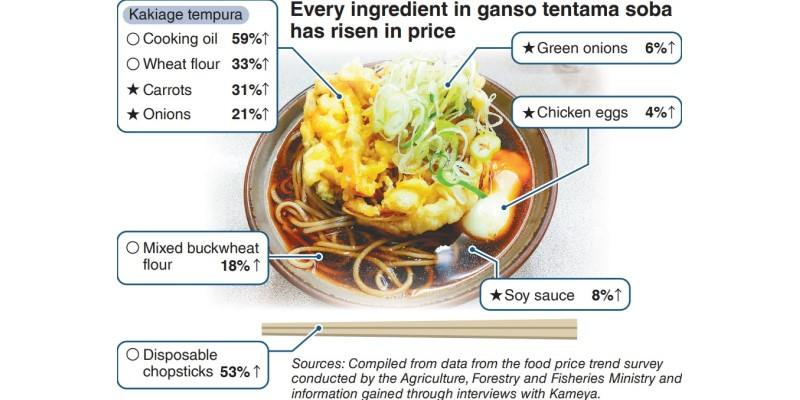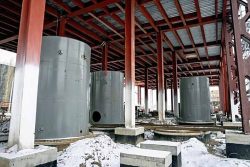
Staff at the Kameya Kanda east gate shop handle the lunchtime rush on Sept. 28, in Chiyoda Ward, Tokyo.
12:57 JST, October 17, 2022
Many businesspeople come and go in Tokyo’s Kanda area during lunchtime on the weekdays. At the long-established soba buckwheat noodle eatery called the Kameya Kanda east gate shop, near the east gate of JR Kanda station, regular customers came in one after another, handing ¥500 coins over the counter.
An employee of the shop gave them their change and quickly served them its specialty, ganso tentama soba with large kakiage deep-fried vegetables and an onsen tamago, or hot-spring boiled egg.
“My salary hasn’t changed, but I feel like everything around me is slowly going up in price. So, I’m grateful that I can eat something for less than ¥500 now,” said a 35-year-old company employee who comes to the eatery at least once a week.
One bowl of ganso tentama soba costs ¥480. A bowl of kake soba plain noodles with no trimmings is ¥310. Both items cost ¥20 to ¥30 more than in April.
“How much should we raise the menu prices?” Behind the scenes, the management of Kameya, a long-established company that runs a chain of soba outlets, was forced to make a difficult decision.
Customer numbers declined amid the COVID-19 crisis and have not fully returned to the level seen in the pre-pandemic days. At the same time, the operator of the soba shop chain has been hit by soaring energy and raw material prices.
Making matters worse is the yen’s rapid depreciation, which is driving up the prices of imported commodities.
“To tell the truth, we wanted to raise our menu prices by at least ¥40,” said Kameya representative Katsuyuki Arakawa, 66. Instead, the company limited the increase to a range of ¥20 to ¥30 to retain and attract as many customers as possible, out of consideration for consumers’ financial situation.

Kameya’s soba and udon are home-made, and its cooking oil and flour are purchased directly from manufacturers or bought in bulk to reduce costs.
These efforts continue but can only do so much. On Oct. 1, the company raised the prices of its tempura by ¥10 to ¥20, increases that it had resisted implementing for some time.
“We’ve entered a range of price increases in which we can’t manage by our own efforts alone. It’s hard because there’s no telling when we can get out of this situation,” said Arakawa, expressing his concern.
Various factors are contributing to the soaring prices of raw materials.
Imports of buckwheat seeds, the main raw material for buckwheat flour, account for approximately 60-70% of domestic consumption. According to the Agriculture, Forestry and Fisheries Ministry, China in 2021 provided about 65% of Japan’s total imports of unpolished buckwheat, followed by the United States at about 15% and Russia at about 14%.
Buckwheat prices have been going up mainly due to the significant decrease in imports from China, which has caused uncertainty to spread over procurement of the product.
Amid the ongoing conflict between the United States and China, China is trying to reduce its dependence on the United States for its procurement of corn and soybeans, by offering subsidies to Chinese farmers who give up growing buckwheat and switch to corn and soybeans.
According to sources, the wholesale prices for Chinese-grown unpolished buckwheat in Japan have increased by 30-40% compared to two years ago.
Furthermore, Russia, a major producer of buckwheat, invaded Ukraine in February, further raising concerns that the global supply of the product will fall.
The trading of commodities has also surged amid the economic recovery following the COVID-19 pandemic, causing continued disruption in supply chain networks. Nikkoku Seifun Corp., a major buckwheat flour maker based in Nagano, in June raised the prices of foreign-made buckwheat flour by ¥50 per kilogram. In addition to the rising prices of buckwheat, ocean freight costs associated with imports have risen to nearly five times their level before the COVID-19 pandemic, according to the company.
Soba eatery chains, for which the low prices of their soba dishes is a selling point, have been forced to raise the prices of their soba items one after another. At Nadai Fuji Soba, a soba eatery chain operated by Daitan Food, a bowl of kake soba cost ¥310 until last year but is now ¥360.
Yudetaro, a soba eatery chain operated by Yudetaro System, raised the price of its kake soba from ¥360 to ¥380 in June. Soba is a popular everyday food in Japan, but it is not immune to the volatile international situation.
Another factor is that the spread of biofuels has increased the demand for soybeans and rapeseed, sending the prices of cooking oil higher. Unseasonal weather worldwide has likewise been pushing up the prices for many food items. According to Tokyo Shoko Research, Ltd., 71 of the 122 leading restaurant chains, or about 60% of the total, have implemented price hikes from the beginning of this year through early September.
The situation is likely to continue for some time, with companies, business operators, and consumers alike struggling to cope with the growing burden of rising costs and prices.
"Business" POPULAR ARTICLE
-

Tokyo Economic Security Forum to Hold Inaugural Meeting Amid Tense Global Environment
-

Keidanren Chairman Yoshinobu Tsutsui Visits Kashiwazaki-Kariwa Nuclear Power Plant; Inspects New Emergency Safety System
-

Imports of Rare Earths from China Facing Delays, May Be Caused by Deterioration of Japan-China Relations
-

University of Tokyo Professor Discusses Japanese Economic Security in Interview Ahead of Forum
-

Japan Pulls out of Vietnam Nuclear Project, Complicating Hanoi’s Power Plans
JN ACCESS RANKING
-

Tokyo Economic Security Forum to Hold Inaugural Meeting Amid Tense Global Environment
-

Keidanren Chairman Yoshinobu Tsutsui Visits Kashiwazaki-Kariwa Nuclear Power Plant; Inspects New Emergency Safety System
-

Imports of Rare Earths from China Facing Delays, May Be Caused by Deterioration of Japan-China Relations
-

University of Tokyo Professor Discusses Japanese Economic Security in Interview Ahead of Forum
-

Japan Pulls out of Vietnam Nuclear Project, Complicating Hanoi’s Power Plans

























